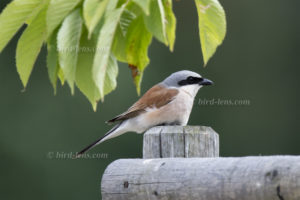 Forest edges and small trees – especially small ones – are the habitat of the Red-backed Shrike (Lanius collurio). A male, clearly visible, secures the half-open habitat.
Forest edges and small trees – especially small ones – are the habitat of the Red-backed Shrike (Lanius collurio). A male, clearly visible, secures the half-open habitat.
From time to time he calls out his unspectacular call, jumps to the ground and then flies back with or without prey on his favorite perch with a good overview. This time, the perch is a post used as a support for a planting of a Cherry tree.
The Red-backed Shrike, which is classified as endangered in Brandenburg, uses dense, low-growing bushes and trees with adjacent insect-rich open land habitats as breeding habitat. The Linnet (Acanthis cannabina), which is also classified as endangered, is its neighbor.
These landscape elements are still widespread in the Nuthe-Nieplitz region. Other typical birds of semi-open habitats structured by trees and shrubs are Greenfinches (Chloris chloris), Goldfinches (Carduelis carduelis) and Yellowhammers (Emberiza citrinella). In particular, the forest edges and structurally rich stocks of trees and bushes with adjacent grass and herbaceous borders offer the species mentioned favorable habitat conditions. The small trees are used as a nesting place and – as with the Red-backed Shrike – as a perch, and adjacent edges or ruderal areas with diverse vegetation are of great importance for the search for food. The adjacent pine forest edges in the region are inhabited by various breeding birds such as Blackcap (Sylvia atricapilla), Eurasian Blackbird (Turdus merula), Chaffinch (Fringilla coelebs), Willow Warbler (Phylloscopus trochilus), Wood Pigeon (Columba palumbus), Eurasian Robin (Erithacus rubecula), Song Thrush ( Turdus philomelos), Wood Warbler (Phylloscopus sibilatrix) and Chiffchaff (Phylloscopus collybita). In wetter habitats, the melodious song of the Common Nightingale (Luscinia megarhynchos) can be heard in spring. The two species Tree Pipit (Anthus trivialis) and Golden Oriole (Oriolus oriolus), which are also on the early warning list in Brandenburg, are still quite common in the forest stands of the Nuthe-Nieplitz region. Due to the hidden way of life, one should listen to the singing or the calls here. Both species are currently in decline.
In order to meet the growing demand for top images of the rarer species of Palaearctic Bird-lens.com has specifically made trips to remote places. Additionally every chance is used, if a rare bird is around the homeground. This to do everything to ensure excellent photos of the Birds of the Western Palearctic . The yield of pictures also of rare Western Palaearctic birds is very good. There are other nice images of birds, that you will find behind the tab “Picture Shop“. Just give a notice if you need a picture of a bird which is not online.